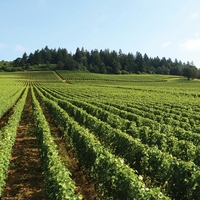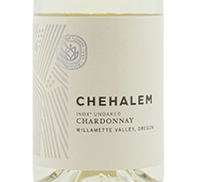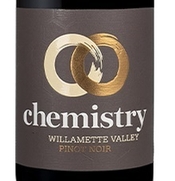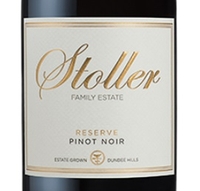I have never met owner Bill Stoller, but the certifications that his  company has achieved suggest that he has a long-term vision for his region, company, and team. The Stoller company holds two major certification programs with exacting standards. The first winery that Stoller built is the first winemaking facility in the world to be LEED® Gold certified, a green building certification program used worldwide. All of his wine properties are B Corp certified. The B Impact Assessment evaluates how a company’s operations and business model impact its workers, community, environment, and customers. It’s not just about investors and the bottom line.
company has achieved suggest that he has a long-term vision for his region, company, and team. The Stoller company holds two major certification programs with exacting standards. The first winery that Stoller built is the first winemaking facility in the world to be LEED® Gold certified, a green building certification program used worldwide. All of his wine properties are B Corp certified. The B Impact Assessment evaluates how a company’s operations and business model impact its workers, community, environment, and customers. It’s not just about investors and the bottom line.
In the mid-2000s I visited the Stoller as the guest of winemaker Melissa Burr. Among of the most unusual and memorable details were the catacombs throughout the winery designed to pull in cool air at night for natural temperature control. The windows were covered with a film to block UV rays. They were the first winery in the Northwest to produce solar energy. The barrel cellar is underground to provide natural cooling.
It is gratifying to see so many women leading and working on winemaking teams. Burr, who was the first winemaker at Stoller, is now the Vice President of Winemaking. She is also responsible for creating History wines made from historic vineyards in the Pacific Northwest.
Kate Payne-Brown Is the winemaker for Stoller. She is a Utah native, with an undergraduate degree from Oregon State University and a master’s degree in Oenology at the University of Adelaide in Australia.
Katie Santora has been at Chehalem since 2012 when she took the assistant winemaker job. She became the winemaker when Stoller acquired the winery in 2018. She leads an all women winemaking team with Jess Spera as the assistant winemaker and Cate Lever as cellar master.
The Stoller Group has three vineyards in three Willamette Valley AVAs.  The oldest is Ridgecrest Vineyard, planted by Harry Peterson-Nedry and his family in 1980. It is a 29-acre site on 200-million-year-old marine sedimentary soil with 22.25 acres planted. Corral Creek Vineyard, which had been planted in 1983 by the Howieson Family was acquired in 1995. It is a 40-acre site on 100 to 50- thousand-year-old Loëss soils planted with 24 acres of vines. Stoller Vineyard was established in 1995. It is a 400-acre site with 210 acres planted on 16 to14-million-year-old volcanic soil and 21 acres planted for Chehalem. The variety of soils from these sites provide different flavor profiles for the wines made from their grapes.
The oldest is Ridgecrest Vineyard, planted by Harry Peterson-Nedry and his family in 1980. It is a 29-acre site on 200-million-year-old marine sedimentary soil with 22.25 acres planted. Corral Creek Vineyard, which had been planted in 1983 by the Howieson Family was acquired in 1995. It is a 40-acre site on 100 to 50- thousand-year-old Loëss soils planted with 24 acres of vines. Stoller Vineyard was established in 1995. It is a 400-acre site with 210 acres planted on 16 to14-million-year-old volcanic soil and 21 acres planted for Chehalem. The variety of soils from these sites provide different flavor profiles for the wines made from their grapes.
With these vineyard sites as resources the Stoller Group is able to make a range of wines from everyday wines to reserves. Oregon made its wine reputation with its characterful Pinot Noirs, so it shouldn’t be a surprise that Pinot Gris, Pinot Noir’s paler sibling, is happy there, too. The Chemistry Willamette Valley Pinot Gris 2019 ($14) is pale gold, with aromas of pear, apple and a bit of kiwi with a hint of wet stone. Flavors are fresh, pure, and light with pear, apple and grapefruit supported by crisp acidity
The Chehalem Willamette Valley Pinot Gris 2019 ($20) is a bit richer with aromas of ripe Bosc pear, wisps of chamomile, and notes of dusty minerals, flavors of pear and green apples are bright and lively with vibrant acidity. It is juicy in the mouth and lean in the finish.
The Stoller Family Estate Willamette Valley Pinot Noir Rosé 2020 ($28) is very impressive and intense. Apparently the 2020 growing season was difficult, beginning with cold and wet weather that limited fruit set. Grape bunches and their berries were very small. Small grapes have a higher skin to juice ratio, which means more flavor for us to enjoy. This Rosé does have plenty of flavor: strawberry, melon, candied peach and floral notes that burst on the tongue. Snappy acidity adds liveliness to the mix and contributes to a long finish.
Having Stoller and Chehalem in the same wine family gave the wine teams the opportunity to collaborate on a new project they named Chemistry. Sourcing grapes from sites throughout the valley they are creating fresh wines at affordable prices “made for life’s everyday moments.” Chemistry Willamette Valley Pinot Gris 2019 ($14) is pale gold with aromas of pear, apple and a bit of kiwi with a hint of wet stone. Flavors are fresh, pure and light with pear, apple and grapefruit supported by crisp acidity.
Chemistry Willamette Valley Chardonnay 2019 ($14) has a pale straw color, aromas of ripe apples, pears and citrus with cool-climate bright acidity. At this price it’s easy to keep a few bottles in the fridge. It is a great wine for sipping or at the table with grilled shrimp or lemon pasta.
 Chehalem Willamette Valley Chardonnay “Inox” 2019 ($19) is a wine I have admired for many years. Pale yellow color and delightfully heady, orange blossom aromas announce succulent flavors of apple, peach, ripe melon laced with floral notes sustained by vivacious acidity. Inox refers to the stainless steel tanks used to ferment and store the wine before bottling. No oak is used in making the wine. As winemaker Katie Santora says, “this wine is first and foremost made in the vineyard,” it is the first wine of a vintage to be released so “it provides a snapshot of the vintage.” Chehalem has been making this wine for many years beginning at a time when the Chardonnay popular style was big and buttery. Santora says that she often has visitors reluctant to taste this wine because they say they don’t like Chardonnay. After tasting Inox, they are amazed that it is indeed Chardonnay, and they like it.
Chehalem Willamette Valley Chardonnay “Inox” 2019 ($19) is a wine I have admired for many years. Pale yellow color and delightfully heady, orange blossom aromas announce succulent flavors of apple, peach, ripe melon laced with floral notes sustained by vivacious acidity. Inox refers to the stainless steel tanks used to ferment and store the wine before bottling. No oak is used in making the wine. As winemaker Katie Santora says, “this wine is first and foremost made in the vineyard,” it is the first wine of a vintage to be released so “it provides a snapshot of the vintage.” Chehalem has been making this wine for many years beginning at a time when the Chardonnay popular style was big and buttery. Santora says that she often has visitors reluctant to taste this wine because they say they don’t like Chardonnay. After tasting Inox, they are amazed that it is indeed Chardonnay, and they like it.
 Chemistry Willamette Valley Pinot Noir 2019 ($19) displays a bright ruby color and spicy black cherry, raspberry aromas. It is very smooth and integrated in the mouth with black cherry, raspberry flavors with a hint of vanilla, well balanced with bright acidity and smooth tannins. Grapes were cold-soaked several days, which extracts color and flavors. It was fermented in stainless steel tanks and aged in oak; 15 percent new. It is a great value and will be a welcome addition to your weeknight dinner.
Chemistry Willamette Valley Pinot Noir 2019 ($19) displays a bright ruby color and spicy black cherry, raspberry aromas. It is very smooth and integrated in the mouth with black cherry, raspberry flavors with a hint of vanilla, well balanced with bright acidity and smooth tannins. Grapes were cold-soaked several days, which extracts color and flavors. It was fermented in stainless steel tanks and aged in oak; 15 percent new. It is a great value and will be a welcome addition to your weeknight dinner.
Stoller Family Estate Dundee Hills Pinot Noir 2019 ($35) presents crystal bright ruby color and deep, black cherry, blackberry, raspberry aromas with hints of dried rose petals, and sweet pipe tobacco. In the mouth, the wine is sleek and polished with focused black cherry, raspberry fruit sustained by citrusy acidity and burnished tannins. It is quite youthful and promises evolution of depth and complexity. Grapes are from their 250-acre estate vineyard in the Dundee Hills where they tend 15 different clones of Pinot Noir. The diversity of grapes grown at altitudes ranging from 210 to 650 feet provide winemaker Kate Payne-Brown a palette of colors and flavors to create the best wine of the vintage.
In the US, there are no rules that define reserve wines, so it is  encouraging when a winery has a definition of reserve. At Stoller, reserve wines come the best barrels of wines made from the oldest vines of Pinot Noir clones, planted between 1995 and 2001. The 2015 vintage was consistently warm until a late August cold front slowed the ripening process that allowed more time for flavors to develop. The Stoller Family Estate Dundee Hills Reserve Pinot Noir 2015 ($50) was aged in 30 percent new oak and 70 percent neutral oak and bottled in December 2016. With four years and three and a half months in the bottle, it is still quite youthful with black cherry, raspberry fruit while developing notes of sandalwood and mocha. It is smooth and round in the mouth with fruit, acidity, and fine-grained tannins melding into a seamless whole. It is drinking beautifully now, but there’s still plenty of life for a few more years, if carefully stored.
encouraging when a winery has a definition of reserve. At Stoller, reserve wines come the best barrels of wines made from the oldest vines of Pinot Noir clones, planted between 1995 and 2001. The 2015 vintage was consistently warm until a late August cold front slowed the ripening process that allowed more time for flavors to develop. The Stoller Family Estate Dundee Hills Reserve Pinot Noir 2015 ($50) was aged in 30 percent new oak and 70 percent neutral oak and bottled in December 2016. With four years and three and a half months in the bottle, it is still quite youthful with black cherry, raspberry fruit while developing notes of sandalwood and mocha. It is smooth and round in the mouth with fruit, acidity, and fine-grained tannins melding into a seamless whole. It is drinking beautifully now, but there’s still plenty of life for a few more years, if carefully stored.
Bill Stoller has built an Oregon wine empire with great vineyards and great people. He did it thoughtfully, methodically with a long-term view to ensure that what he has built will still be there long after he is gone.
Connect with her on Twitter at @RebeccaOnWine
